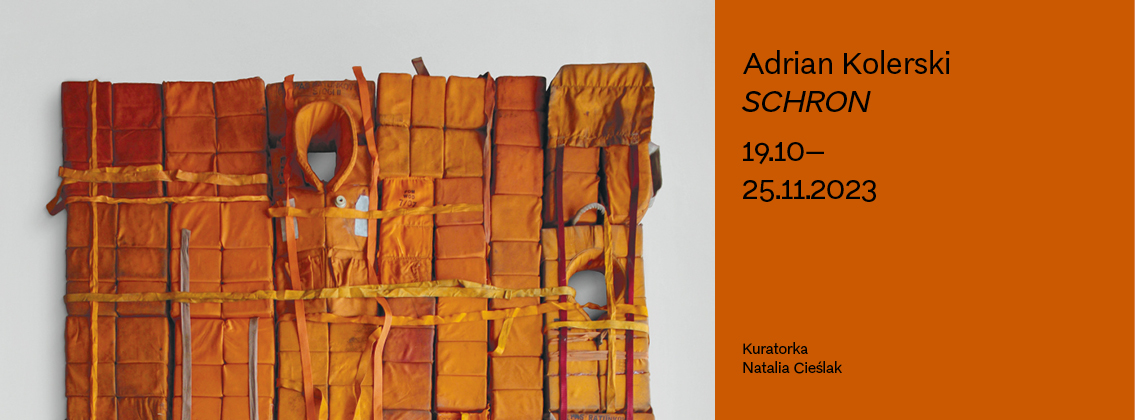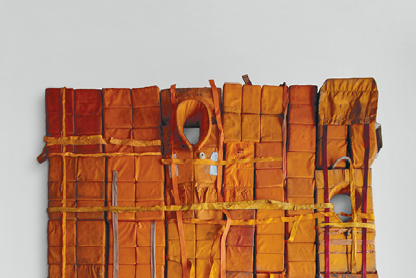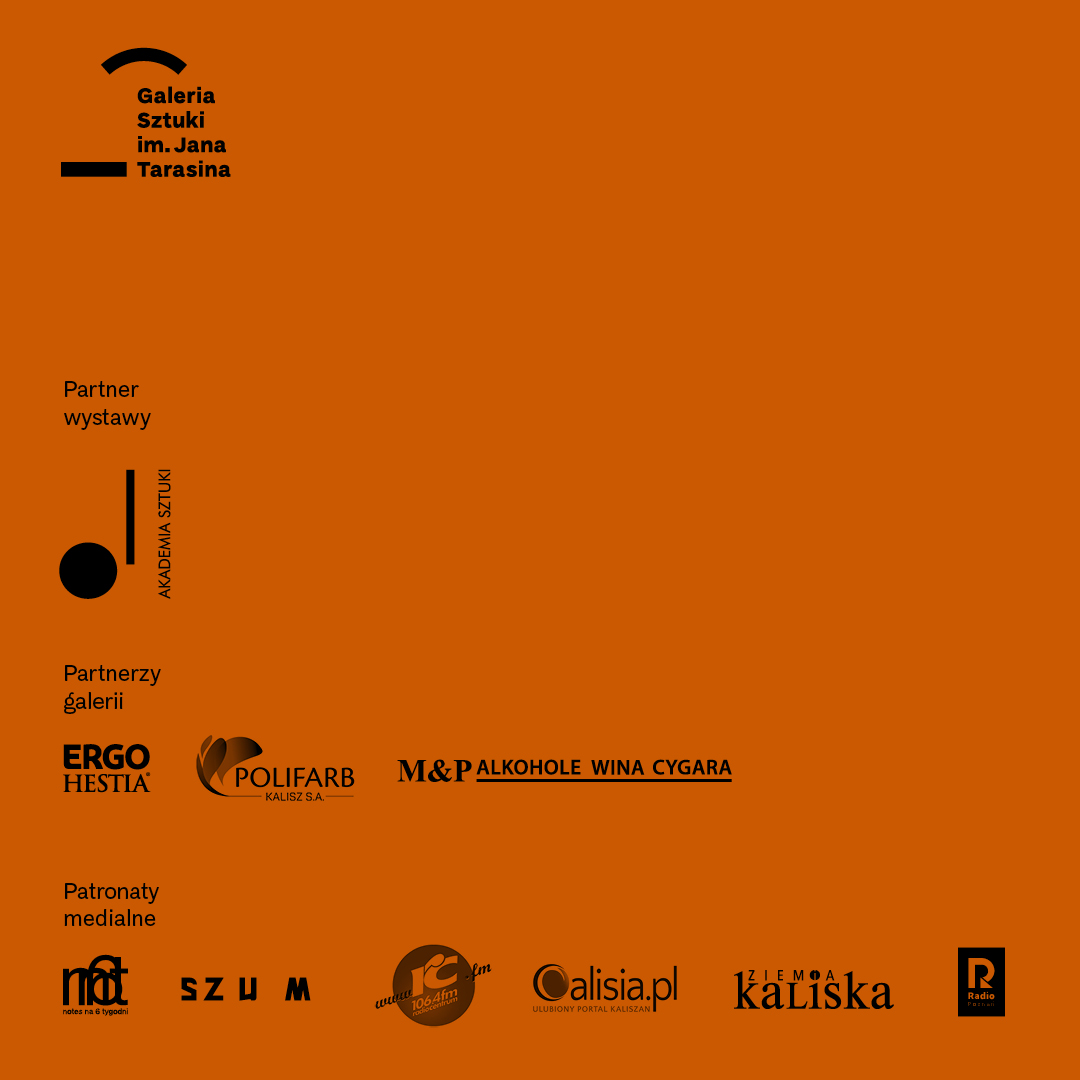
As part of the cyclical project STOP WITH ART from October 19 to November 25, 2023, the Jan Tarasin Art Gallery is presenting selected works by Adrian Kolerski in seven bus stop windows. This is one of the installments of the exhibition “SCHRON”, which is presented at the same time at the Jan Tarasin Art Gallery in Kalisz.
The exhibition Shelter by Adrian Kolerski is the realization of Natalia Cieślak’s curatorial project, which has been awarded in the 6th Curator’s Competition organized by the Kalisz City Art Gallery.
It feels (…) as if I was standing not in front of my house, but in front of myself in a dream and was lucky to be sleeping deeply, being able to guard myself at the same time.[1]
Franz Kafka, The Burrow
The exploration of the post-industrial surroundings of Szczecin, the hometown of Adrian Kolerski, caused him to experience a collision of imaginations and reality. Observation of the progressive ruination of the once lively, bustling areas next to the dockyard – directly adjacent to the residential where he grew up – or the discovery of the underground bunker located almost just below his house, changed the way the artist’s perception of the seemingly well-known environment. His study, performed after years, made it reveal a new face, it became difficult to recognize, as if “distorted.” The new context made it be strange and peculiar. This impression of the incredibleness of places and objects, de facto representing reality, became the essence of the project presented by Kolerski at Jan Tarasin Art Gallery in Kalisz.
The arrangement of the exhibition, somewhat reminiscent of the scenery from a science-fiction movie immersed in a dystopian atmosphere, reflects the vision of the unpleasant, rough, rough world. It is hard to resist the impression that – like Kafka’s burrow or an anti-missile shelter – like a mirror, the exhibition space reflects the internal situation of a man, in the opinion of which on the horizon of future events there is a forecast threat. Paintings and objects allusively draw his moods, situation and aspirations. The need for preparation in the event of a threat, protecting yourself and safeguarding your material heritage from destruction stands in the foreground. This is signaled by, among others, Materials utilized by the artist: elements of worn rescue vests (Rescue vest 2) or cardboard and adhesive tape, used to protect what needs to be stored for later (paintings Without title). In turn, in the title of the Capsule/Sarkophagus series, we will see a reference to a tightly closed container or an isolated part of the spacecraft, ensuring survival in separation from the negative impact of external factors. The paintings placed by Kolerski in these peculiar “packages” resemble the data saved on Voyager Golden Record – a record released into space on board the NASA research probe.[2] A series of information stored there is to show the finders (people from the future or foreign civilizations) the various forms of life and cultures on our planet. However, the question remains – similarly to the images closed in the capsules – they will be read, being deprived of context. Maybe they will remain “dead,” and the sarcophagus will not store them as much as it will become their casket?
The works presented at the exhibition combine closer or further associations with the objects we know. Dummy-images, e.g. Without a title (Hatch), are a synthetic form referring to real objects, but the meaning of individual productions and the role they play is open to speculation, and their status-rarely specified. This is because Kolerski’s works, although they reveal relationships with the forms referred to everyday experience (e.g. a mattress in Residential form), are not a literal substitute for real objects. They also take shapes that are not clearly determined, which makes them susceptible to guesses about their character. We consider them as kind of-real, but probably dysfunctional. Rather, they act in a way that is incompatible with the original purpose or has broken off from the usual roles assigned to them. Either they were “put to sleep” or their usability was invented again. What was the reason for this? Maybe daily practices lost their importance, and solid structures of existence gave way to unstable foundations? The dynamics of life and its goals have changed, which has opened a new stage of the biography of objects? The conditions forced the need to adapt and use them to carry out tasks for which they were not originally intended?
The observed removal of objects from the world they belonged to, and the loss of the original sense opens the field to create new, unknown scenarios, to which Kolerski encourages the viewers of his art.
Natalia Cieślak, curator.
Adrian Kolerski (born in 1986) – deals with painting, object and video. He graduated from the Faculty of Painting of the Academy of Fine Arts in Krakow. In the years 2015–2017 he conducted classes at the Multimedia Department at the Faculty of Arts of the Pedagogical University of Krakow. Since 2017, he has been working as an assistant in the 4th Painting Workshop at the Faculty of Painting of the Academy of Arts in Szczecin. Winner of the artistic scholarship of the Mayor of Szczecin (twice), Creative scholarship of the Minister of Culture and National Heritage and the Creative Scholarship of the City of Szczecin. His works were shown at exhibitions in the Zona Sztuki Aktualnej Gallery in Szczecin, Bunkier Sztuki in Krakow, BWA Warszawa, Stefan Gierowski Foundation, the National Museum in Szczecin, the National Museum in Krakow and others. He lives and works in Poznań and Szczecin.

Exhibition duration: Oct 19-Nov 25, 2023
Organizer: Jan Tarasin Art Gallery in Kalisz, Cultural Institution of the City of Kalisz.
The exhibition can be viewed in the shop windows of seven bus stops in the city of Kalisz:
Parczewskiego 02
Plac Jana Pawła II 01
Górnośląska Kaliniec 03
Wyszyńskiego Słoneczna 10
Chopina II LO
Nowy Rynek Babina 06
Śródmiejska Złoty Róg
Exhibition Partner:
ACADEMY OF ARTS IN SZCZECIN
Media patronage:
NOTES NA 6 TYGODNI, Magazyn SZUM, Radio POZNAŃ, Radio Centrum, Ziemia Kaliska, CALISIA.PL
Gallery Partners:
ERGO HESTIA, POLIFARB KALISZ S.A., M&P ALKOHOLE WINA CYGARA

[1] Franz Kafka, Jama [English: The Burrow] Jarosław Ziółkowski[in:] the same, Opowieści i przypowieści [Stories and parables], afterword: Karol Sauerland, PIW, Warsaw 2016, p. 590.
[2] The “cosmic” threads also appeared in Kolerski’s other projects, e.g. as part of the exhibition at the Pale Blue Dot in Zona Sztuki Aktualnej gallery in Szczecin (2018).








